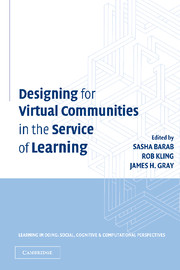Book contents
- Frontmatter
- Contents
- List of Contributors
- Series Foreword
- Foreword
- Preface and Acknowledgments
- In Memoriam
- PART I COMING TO TERMS WITH COMMUNITY
- PART II DESIGNING FOR WEB-SUPPORTED COMMUNITY
- PART III FOSTERING COMMUNITY/MEMBER PARTICIPATION
- 7 The Centrality of Culture and Community to Participant Learning at and with The Math Forum
- 8 An Exploration of Community in a Knowledge Forum Classroom
- 9 Co-Evolution of Technological Design and Pedagogy in an Online Learning Community
- 10 From Ambitious Vision to Partially Satisfying Reality
- PART IV RESEARCHING ONLINE COMMUNITY
- Index
- Titles in the series
- References
8 - An Exploration of Community in a Knowledge Forum Classroom
An Activity System Analysis
Published online by Cambridge University Press: 05 June 2012
- Frontmatter
- Contents
- List of Contributors
- Series Foreword
- Foreword
- Preface and Acknowledgments
- In Memoriam
- PART I COMING TO TERMS WITH COMMUNITY
- PART II DESIGNING FOR WEB-SUPPORTED COMMUNITY
- PART III FOSTERING COMMUNITY/MEMBER PARTICIPATION
- 7 The Centrality of Culture and Community to Participant Learning at and with The Math Forum
- 8 An Exploration of Community in a Knowledge Forum Classroom
- 9 Co-Evolution of Technological Design and Pedagogy in an Online Learning Community
- 10 From Ambitious Vision to Partially Satisfying Reality
- PART IV RESEARCHING ONLINE COMMUNITY
- Index
- Titles in the series
- References
Summary
The past two decades have witnessed a remarkable transformation in the theoretical landscape of educational research. Classical in-the-head conceptions of thinking and learning are now sharing the epistemic spotlight with the sociocultural and sociohistorical theories of Vygotsky, Leont'ev, and Luria (Kuutti, 1996). These new perspectives argue that learning is fundamentally a social activity, inextricably tied to participation in communal practices (Lave & Wenger, 1991; Rogoff, Baker-Sennett, Lacasa, & Goldsmith, 1995). Accordingly, there has been a growing interest in the notion of community in educational circles, and the ways in which social groupings can be designed to advance individual and collective cognitions.
Like any theory of learning, sociocultural perspectives are susceptible to misinterpretation and oversimplification. The notion that development “is a process of participation in sociocultural activities” (Rogoff et al., 1995, p. 45) offers a new way of thinking about cognition and meaning, but it can also lead to unwarranted optimism regarding the educational efficacy of community-based strategies. While sociocultural theory has been widely interpreted as a call for framing pedagogies around social engagement, it would be a mistake to assume that any form of group activity will yield desirable educational outcomes. The word community is popularly (and sometimes erroneously) applied to a broad range of social organizations, from informal Internet chat rooms to carefully crafted models of classroom activity (e.g., CTGV, 1992; Brown & Campione, 1990; Riel, 1992; Scardamalia, Bereiter, McLean, Swallow, & Woodruff, 1989). Clearly, some kinds of community engagement offer more educational promise than others.
- Type
- Chapter
- Information
- Designing for Virtual Communities in the Service of Learning , pp. 210 - 238Publisher: Cambridge University PressPrint publication year: 2004
References
- 16
- Cited by



